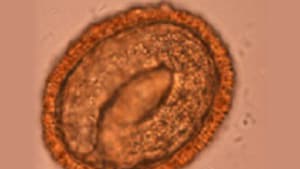At a glance
- The clinical presentation of baylisascariasis depends on the number and the location of larvae in the body. Non-specific signs and symptoms may appear as soon as one-week post-infection and could include nausea, fever, and lethargy. Specific clinical presentations vary depending on the dose and location of migrating larvae in the body.

Signs and symptoms
Humans are a paratenic (intermediate) host, meaning that infection by larval stages of the parasite can occur but the parasite does not complete its lifecycle in the host. In paratenic hosts, adult worms do not develop in the intestine, and eggs will not be observed in the feces. The clinical presentation of baylisascariasis depends on the number and the location of larvae in the body. The infecting dose of larvae may be related to the disease presentation; when large numbers of embryonated eggs are ingested, larvae may be more likely to penetrate the central nervous system, causing neural larva migrans. Death or permanent disability is a common outcome of neural larva migrans due to Baylisascaris.
Non-specific signs and symptoms may appear as soon as one week post-infection and include but are not limited to nausea, fever, and lethargy. Specific clinical presentations vary depending on the dose and location of migrating larvae in the body.
- Neural larva migrans often presents as acute eosinophilic meningoencephalitis. Signs and symptoms may develop within 2 to 4 weeks after ingestion of large numbers of infective eggs and include weakness, incoordination, ataxia, irritability, weakness, seizures, altered mental status, stupor, and/or coma. Once symptoms and signs of neurologic disease are detected, significant pathology generally is already present.
- Ocular larva migrans may present as diffuse unilateral subacute neuroretinitis. photophobia, retinitis, and/or blindness (typically unilateral). This manifestation can occur with neural larva migrans or alone.
- Visceral larva migrans may be associated with macular rash, abdominal pain, hepatomegaly, and pneumonitis. Larvae can cause inflammatory reactions in organs and tissue damage. Skin infection and inflammation have been reported.
Of note, a number of other parasitic nematode infections may cause similar signs and symptoms, such as infection with larvae of Toxocara spp. and Angiostrongylus spp. The pathogenesis of this disease is similar to that of Toxocara infection. However, the clinical course often is more severe because, unlike Toxocara, Baylisascaris larvae are larger and continue to molt and increase in size, resulting in extensive reaction and damage in the CNS, heart, and other internal organs.
Consider Baylisascaris infection in persons with severe developmental disabilities or pica/geophagia and sudden onset of eosinophilic encephalitis. A history of exposure to raccoons or their feces is highly suggestive but not necessary.
Resource
Diagnosis
Diagnosis of baylisascariasis can be difficult. Diagnostic findings include eosinophilic pleocytosis, peripheral eosinophilia, deep white matter abnormalities on MRI, and positive Baylisascaris antibody titers on serologic testing of CSF and serum. Neuroimaging and encephalography may assist with identifying neural larva migrans. Ocular examinations may reveal a migrating larva, larval tracks, or lesions consistent with presence of a nematode larva in the eye.
Examination of tissue biopsies and morphological identification of larvae may be helpful, but depending on the number of larva it may be problematic to acquire an effective sample (one with a cross-section of a larva). Larvae can become encapsulated within granulomas.
There is no commercially available serological test for baylisascariasis. However, CSF or serum may be tested for antibodies at CDC if the index of suspicion is high in cases of clinical disease. Serological testing for other nematode infections should be considered and may help to diagnose other causes of larva migrans if Baylisascaris serology is negative. Please contact CDC if for more information about baylisascariasis testing.
